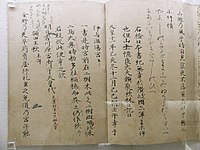Old Japanese
Old Japanese (上代日本語, Jōdai nihongo) is the oldest known form of the Japanese language.
| Old Japanese | |
|---|---|
| 上代日本語 | |
 Manuscript of the Man'yōshū, recording Old Japanese using Chinese characters | |
| Region | Japan |
| Era | Evolved into Early Middle Japanese during the Heian period |
Japonic
| |
| man'yōgana | |
| Language codes | |
| ISO 639-3 | ojp |
ojp [a] | |
| Glottolog | oldj1239 |
It is difficult to give a precise date when Old Japanese started. The date when the Old Japanese period is said to have finished is 794. It was the start of the Heian period.
The Japanese writing system came from the Chinese. Wooden tablets have been found with writing on. The oldest extended piece of writing we know of dates from 712. This is the start of the Nara period (710-794).
The earliest texts found in Japan are written in classical Chinese. However, some of them show the influences of Japanese grammar (e.g. word order). Sometimes bits of Chinese characters are used to make the sound of the small Japanese words called “particles”. This helps us to make some guesses about how it used to be pronounced.
Many changes in the Japanese language took place over the centuries. The spoken form of Japanese changed much more quickly than the written form.
Related pages
changeReferences
changeNotes
- ↑ Described as "The ancestor of modern Japanese. 7th–10th centuries AD." The more usual date for the change from Old Japanese to Middle Japanese is ca. 800 (end of the Nara era).